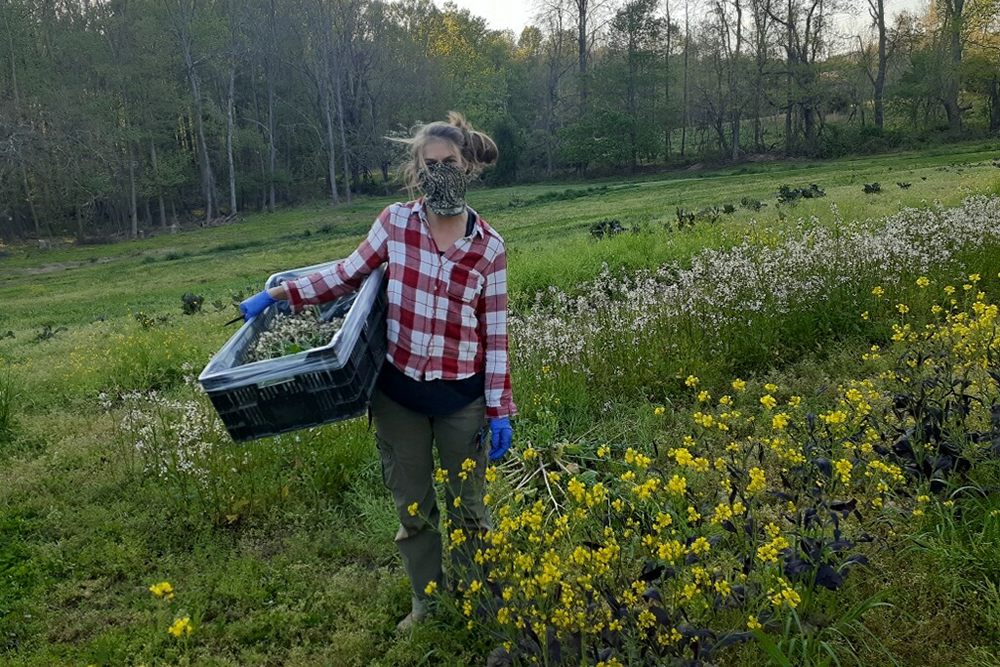Eat
 Rory Chipman. Photo courtesy of Willowsford Farm.
Rory Chipman. Photo courtesy of Willowsford Farm.
Connect the Dots: Repairing Broken Links in the Regional Food Supply Chain
June 5, 2020 @ 10:00am
Our food system today is a textbook paradox. We see thousands of gallons of milk dumped away, tons of produce left to rot and millions of animals euthanized. Yet miles-long lines form at food banks and grocery stores have spotty inventory. Consumers have been rightfully outraged at the food waste and flummoxed by the incongruities. How can these two realities be so incompatible, yet exist side by side?
The simple answer is the food system wasn’t built for this. For decades, our supply chain has been methodically consolidated and streamlined to make cheap food fast – from fields to grocery shelves. The result is a massive, centralized system with little room for error.
Add a global pandemic, and the whole thing starts to crumble. The little cracks that have always existed widen and reach a breaking point, and the operations in motion are too big and too rigid to quickly pivot.
“A large ship is hard to turn around,” says Dena Leibman, executive director of Future Harvest Chesapeake Alliance for Sustainable Agriculture.
The disconnects we see in the headlines are a result of broken links in the supply chain at various points, namely packaging, distribution and labor. According to the United States Department of Agriculture, about 30 percent of daily calories for the average American are consumed outside of the home – at restaurants, schools, universities, hotels and other institutions. When these settings abruptly closed, demand shifted heavily to grocery stores.
Producers who supply large-scale institutions were then stuck with mountains of inventory and costly obstacles in reaching direct-to-consumer markets. Automated packaging plants would require millions of dollars in investment to change from half-pints of milk for school lunches to gallon containers for the grocery store, for instance. Then there’s the issue of sheer volume – people don’t consume potatoes and onions in the same capacity at home as they would french fries and onion rings at ball parks and restaurants. Plus, when the major meat processing plants closed because of Covid cases, farmers were left with growing animals but nowhere to take them and no income to feed them.
With all these challenges, size matters. For local and regional food systems, we’re seeing a different story.
“It’s just much more nimble a system,” Leibman says. Small farmers have pivoted, collaborated, and gone into overdrive to adapt to market changes and get their food to people who need it. Nonprofit organizations have also stepped up to help.
Economies of Collaboration
Many organizations have united as part of a new coalition designed to address these supply chain disruptions. The Mid-Atlantic Food Resilience and Access Coalition (MAFRAC) was a mere idea before this crisis began, but it launched exactly when needed most.
“Food systems are more resilient if they’re distributed,” says Tom McDougall, founder and CEO of 4P Foods, a founding partner of MAFRAC.
Instead of economies of scale, MAFRAC seeks to build smaller economies of collaboration, a term coined by Farm Fare, a food hub software platform.
“You can achieve efficiencies if you work together across the regional network and decentralize,” McDougall says. “You can achieve price savings and you can achieve some of those things that economies of scale and big industrial agriculture are going for by being vertically integrated, by being much more cooperative.”
MAFRAC focuses on connecting the dots between producers, distributors, emergency feeding operations and consumers in the region.
“The regional level, which is slightly larger than the local level, seems to be the right mid-size opportunity to gain some of those economies of collaboration,” he adds. “This unit of scale seems to be the sweet spot that’s big enough to realize some efficiencies but not too big to be replicating the industrial system that is too big.”
Their work began with asset mapping and gap analysis.
“Do you have food, but you need bodies to help put it into boxes and you need vehicles to get it to a place?” McDougall asks. “Do you need cold storage because you got a bunch of food donated to you, but it’s going to go bad because you don’t have a refrigerator? We thought that MAFRAC could be essentially that infrastructure, that coordination backbone to help think and strategize regionally to allow partners on the ground to execute hyper-locally.”

Emma Jagoz at Moon Valley Farm. Photo by Jason James.
Finding New Markets
In this role, MAFRAC has numerous big wins. They connected the Nationals Park World Central Kitchen site to people in need in Prince George’s County. They helped a Virginia farm get high-protein peanuts into shelf-stable emergency food boxes sponsored by the D.C. government.
Michael King, the co-owner of Twin Springs Fruit Farm in Pennsylvania, reached out to MAFRAC when he found himself with 16 tons of apples without a market. At the outset of the crisis, his operation quickly pivoted to offer preorders for pickup at their numerous farmers market locations around the DMV. They were still seeing sales of produce, but not all of their inventory was moving.
“Everything changed and our cider sales dropped way down,” King says. “As we grade our fresh number one apples to sell to the customers at market, we take the number twos and put them in a bin, and then we take them to the cider press and they make cider with it. Those started piling up. We just weren’t using very many of them.”
MAFRAC helped King find a home for those apples, in the form of applesauce being packed into D.C. government-funded food boxes for residents in need. King said without that connection, he would have had to sell the apples for 13 cents a pound to another cider processor that makes cider for grocery stores, which would have netted around $3,800. Instead, he made $13,000 for the same quantity of apples.
Now, King has found new outlets for his imperfect apples, which are perfectly good to eat but may be slightly blemished, under-colored or the wrong size. He’s been contacted about produce sales by church emergency feeding programs. So far, he’s sold more than 1,000 pounds of apples to one church and plans to fill produce boxes with greens, potatoes and apples for another.
“I expect another one any day now, someone saying ‘Hey, we’re trying to feed people that are in need, and do you have anything?’ And I think I might have to say no to the next one,” he says. “I’m at the point where I’m going to go crazy if I have any more details to work on, any more things pulling at me in my life.”
Though King says he doesn’t think he’ll make a profit on the reduced-price produce boxes, at least he’s breaking even. The farmers markets are much more lucrative, and he’s even started buying produce from other farmers with excess inventory.
“We have a following,” King says of his farm’s 10,000+ newsletter reach. They can easily sell to consumers, whereas farmers who were working exclusively with restaurants may have a harder time building a new customer base.
Kenneth Martin of Earth N Eats Farm in Pennsylvania is one of the farmers who King has bought from. Previously, Martin sold his greens, tomatoes, cucumbers and eggs to D.C.-area restaurants via his brother Josiah Martin’s business, Earth N Eats LLC, a co-op that encompasses about 15 farms in Pennsylvania, Maryland and West Virginia.
“When the restaurants closed we [lost] 90 percent of our sales.” Kenneth says. We stayed like that about one week. We dumped around $5,000 worth of greens and lettuce to our chickens.”
Josiah said his restaurant sales are currently 30 to 40 percent of normal levels. The Martins quickly looked into other options, from door-to-door delivery to Community Supported Agriculture (CSA) models. With the help of chefs and volunteers, they were able to pivot to sell CSA boxes via restaurants, including The Red Hen, All Purpose and Acqua Al 2. They also have several neighborhood drop sites, set up in partnership with the chef at Via Sophia.
“Now we have to pack everything in smaller amounts. It is more labor intensive,” Kenneth explains. He estimates about 10 percent of their product goes to Twin Springs, with the rest being sold via CSA boxes. “This might have [led] us to a new market. We will just have to wait and see how the demand is after everything opens back up. We have a lot to be thankful for. It could have went much worse.”
Jimmie Robinson of My Sunshine Farm in Virginia also saw an immediate drop in sales when restaurants closed. His farm is only in its second year of operations, and he had two primary customers for the eggs from his 350 chickens – a gourmet pasta maker and a restaurant.
At first, he was able to sell directly to customers who were searching for a source for eggs.
“I made a tent, kind of like a farm stand of my own,” he says. “That only lasted a couple weeks, and then eventually the eggs caught up, and I was stuck.”
His chickens lay 140 dozen eggs per week, and he stores them in four refrigerators in his house.
“Chickens keep eating and they keep laying, and I only have so much space,” he says. “After one week, it’s full.”
He contacted MAFRAC for help, and they connected him with Neighborhood Restaurant Group’s (NRG) new grocery service, Neighborhood Provisions. “They saved the farm,” he says. They gave him a fair price for his pasture-raised eggs, which Robinson was struggling to sell to the public.
“They have the marketing niche,” he says. “That’s the hardest thing. The labels, the hours on a website, and that’s what this company’s able to do. My dozen eggs, they’re able to package it. They put the polish on it.”
If he hadn’t found a market for his eggs, Robinson said he would have had to donate them, but he wouldn’t have been able to sustain that for long.
“The chickens are still eating, so I’d be going into the hole every week on both ends,” he says. “I’d lose on the profit and I’d have to still buy more feed. That’s coming out of my pocket.”
He estimates he could have kept that up for a month before getting into serious financial trouble.
As a new farm, Robinson says he is working to grow his operation to include heritage-breed pigs and turkeys, milking goats and produce. These all require up-front investment and take time to raise and grow before they can be sold. The regular flow of income from selling eggs is what allows him to pay for animals, seed and equipment.
“It’s a balance between the chickens and whatever debt I can handle,” he says. “If I had to get rid of the chickens, I’d be done.”
In cases where a farmer does have to take a loss on products or euthanize animals, consumers wonder why they can’t just donate it, as Robinson said he might. It’s not always that simple. There are costs involved with the labor and materials needed to harvest, package, process and transport the food. If a farmer is already in the hole, they can’t afford to spend more money just to give the food away and gain nothing in return.
Raising Funds to Back Donations
Leibman and her team at Future Harvest saw this dilemma and wanted to do something about it.
“There was just this huge cry for farmers to donate to food banks,” she says. “We felt that they should be paid to do so as much as possible, because they’re also suffering.”
Thus, the Feed the Need campaign was born.
“We actually pay farmers to divert an equivalent portion of their harvest to people in need,” Leibman explains.
The campaign aims to raise $30,000 and will be distributed in grants ranging from $500 to $5,000.
How the farmer donates their food is ultimately up to them – it could be a delivery to a food bank or a sliding scale CSA program. Future Harvest has partnered with 15 food banks that could receive the donations.
“They just have to report to us what they did, how much produce was donated for the amount that they got,” Leibman says. “They have to document the point of delivery with a photograph so that we can continually raise money for this.”
Bread for the City is one of the partner organizations that could stand to benefit.
“During the early days of the pandemic in D.C., we immediately began to struggle to source as much food as we needed for the 5,000 households we typically served each month,” says CEO George Jones.“The convergence of stay-at-home orders and increased demand for food across the Metro area made accessing the huge quantities of food we needed to serve our community members incredibly difficult. Our staff reached out to any sources for purchased or donated food we could secure.”
They connected with local farms, large producers like Mars and Beyond Meat, wholesalers like Costco and Sam’s Club, and the Capital Area Food Bank.
“Over the past four or five weeks, we have been able to get enough to once again provide food to the 300 to 400 families per day we were serving before the pandemic,” Jones says. “In fact, over the past two weeks or so, we are probably serving between 400 and 500 families per day.”
They have seen a total of 2,000 to 3,000 pounds of donated produce from farms, while they have paid for more than 20,000 pounds. “There was a time, pre-Covid-19, when we were getting 2,000 pounds of produce donated a week,” he adds.
This had been coming from farmers markets.
The receiving end of donations poses another challenge – not all food banks have the capacity to store huge quantities of food long term.
“Our storage is relatively limited,” Jones explains. “We have to get a day or two’s worth [of food] every day.”
In another effort to buy food from farmers, chef Edward Lee has focused the second phase of his charitable response to the crisis on reconnecting the link between farmers and restaurants.
The LEE Initiative’s Restaurant Reboot Relief Program will purchase at least $1 million of food from sustainable farms in 17 regions around the country, including the DMV, and donate the food to restaurants in those regions that have a track record of supporting sustainable farms.
“For me personally, these are the farms where I get my products from,” Lee says. “When you don’t have access to them, if they go out of business, who will we buy our meat and chicken and produce from? For an independent restaurant, that’s what defines us.”
The money will be spent via six- to nine-month contracts with farms.
“Regardless of demand, they know that they can grow at least a certain amount of product, and they know they have a guaranteed sale of a certain amount of product,” Lee says. “So they can figure out what the next growing season or livestock season looks like for them.
“They have to plan ahead. We can’t just say to the farms, ‘We don’t need your products anymore.’ Six months from now, I can’t call you and say , ‘Oh by the way, I need 400 pounds of chicken.’ That’s just not how farms work. If they don’t have a steady consistent supply of cash coming in, they can’t reinvest for the next crop.”
In addition to supporting farmers, these funds will help restaurants get back on their feet as they reopen.
“It’s really important that we support these restaurants in the opening stage because that’s when you’re going to see restaurants really go under.
“For a small restaurant to restock everything they need to be open for service, it can be anywhere from $20,000 to $30,000. That’s a huge expense when you’re basically already in debt now,” Lee says. “We’re trying to alleviate some of that. If we can give a restaurant $7,000 [or] $8,000 worth of product, that’s a huge weight lifted off them, and maybe they can use that money to make their first payroll.”
MAFRAC is also putting dollars into the local food system. They have been raising money to support locally grown food being utilized in emergency feeding operations. Their funds will cover what McDougall calls the delta – the cost difference between industrial commodity products versus local. They have already begun financing initiatives like swapping local produce into NRG’s donation of food boxes to individuals in need.

Earth N Eats Greenhouse. Photo courtesy of Kenneth Martin.
Right-Sizing the Supply Chain
Leibman sees the agile adaptations of the local food system as a ringing endorsement for keeping things closer to home.
“We have seen in this pandemic how important a robust regional, local food system is and how vulnerable and frazzled this global supply chain is,” she says. “We need to right-size the local and regional supply chains.”
The crisis has shone a spotlight on the inequities and flaws in the food system, and many people are noticing them for the first time. McDougall sees that as a silver lining, “When this is all over and we walk into a new normal, don’t go back to forgetting,” he says. “These systemic failures, these systemic inequities have been here all along and people have turned a blind eye to it… Do not shut your eyes again.”
Instead, he hopes this is a chance to start fresh with the food system and bolster local and regional networks.
“I think there’s an opportunity to do that with an equity lens and specifically a racial justice equity lens as the primary North Star,” he says. “I think it’s a real opportunity to come out the other end of it with something that looks much better than it did before.”
Visit the following websites to learn more.
Bread for the City: www.breadforthecity.org
Earth N Eats: form.jotform.com/200929344215149
Future Harvest Chesapeake Alliance for Sustainable Agriculture: www.futureharvestcasa.org
The LEE Initiative: www.leeinitiative.org
The Mid-Atlantic Food Resilience and Access Coalition: www.mafrac.com
My Sunshine Farm: www.mysunshinefarm.com
Neighborhood Restaurant Group: www.neighborhoodrestaurantgroup.com
Twin Springs Fruit Farm: www.twinspringsfruitfarm.com
Enjoy this piece? Consider becoming a member for access to our premium digital content and to get a monthly print edition delivered to your door. Support local journalism and start your membership today.







